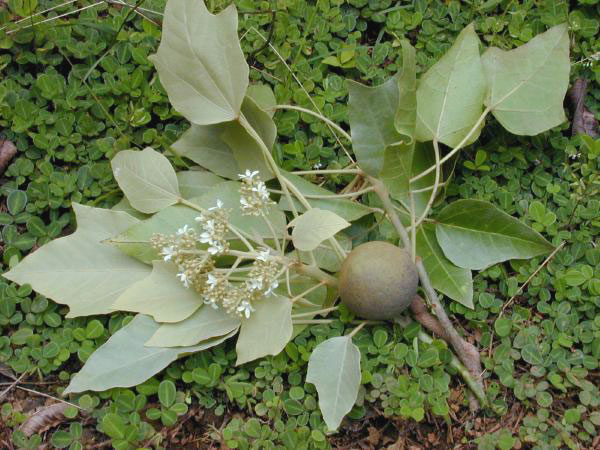- Aleurites
image_width = 240px
image_caption = "Aleurites moluccana" (Candlenut)
regnum =Plant ae
divisio =Magnoliophyta
classis =Magnoliopsida
ordo =Malpighiales
familia =Euphorbiaceae
subfamilia =Crotonoideae
tribus =Aleuritideae
subtribus =Aleuritinae
genus = "Aleurites"
genus_authority = J.R.Forst. & G.Forst.
subdivision_ranks = Species
subdivision = See section Species."Aleurites" is a small arborescent genus of plants in the tropical and subtropical regions of
Asia , thePacific andSouth America , belonging to the Spurge familyEuphorbiaceae .These monoecious, evergreen
tree s are perennials or semi-perennials. These are large trees, 15-40 m tall, with spreading drooping and rising branches.The leaves are alternate, lobate, ovate to ovate-lanceolate with minute stipules. They are pubescent on both sides when young, but in a later stage they become glabrous.
The
inflorescence consists of terminal plumes of small, creamy white bell-shaped fragrantflower s, branching from the base. The flowers are usually bisexual, with a solitary pistillate flower at the end of each major axis. The lateral cymes are staminate. There are five or six imbricate petals. The staminate flowers are mostly longer and thinner than the pistillate flowers, with 17-32 glabrous stamens in four whorls. The pistillate flowers have a superior ovary.The
fruit s are rather large drupes with a fleshy exocarp and a thin, woody endocarp. They vary in shape, according to the numbers of developed locules. They contain oleiferousseed s. These seeds arepoison ous.The oil has been used as a
paraffin , lubricant or as a constituent of varnish, paint or soap. It has also been used as baking oil, after removing the poisonous substances.Some deciduous Chinese species are now classified under a separate genus "Vernicia".
The name "Aleurites" is derived from a Greek word meaning "wheaten flour", because of the appearance of the lower surface of the leaf.
pecies
The most widespread species is the
Candlenut (" _la. Aleurites moluccana"), occurring from tropical Asia, the Pacific, from India to China and Polynesia, Australia and New Zealand. Some botanists only recognize two species, " _la. Aleurites moluccana" and " _la. Aleurites rockinghamensis".
*"Aleurites angustifolia " - (New Caledonia )
*"Aleurites cordata " - (China )
*"Aleurites erratica "
*"Aleurites integrifolia " - (New Caledonia)
*"Aleurites javanica " - (Java)
*"Aleurites moluccana" - Indian walnut, candlenut tree, country walnut, aburagiri, ama
**" _la. Aleurites moluccana" var. " _la. floccosa" - (New Guinea )
**" _la. Aleurites moluccana" var. " _la. katoi" - (Hawaii )
**" _la. Aleurites moluccana" var. " _la. moluccana"
**" _la. Aleurites moluccana" var. " _la. rockinghamensis" - (New Guinea,Australia )
*"Aleurites pentaphylla " - (East Asia )
*"Aleurites remyi " - (Hawaii )
*"Aleurites saponaria " - (Philippines )
*"Aleurites triloba " - (Pacific )*" _la. Aleurites fordii" (now "
Vernicia fordii ") - varnish tree, tung tree, tung oil tree (China)
*" _la. Aleurites montana" (now "Vernicia montana ") - wood-oil tree, mu oil tree.The genus is also known by the synonym " _la. Camirium"
Gaertn. References
* Stuppy, W., P.C. van Welzen, P. Klinratana & M.C.T. Posa. 1999. Revision of the genera Aleurites, Reutealis and Vernicia (Euphorbiaceae). "Blumea" 44: 73-98.
Wikimedia Foundation. 2010.

